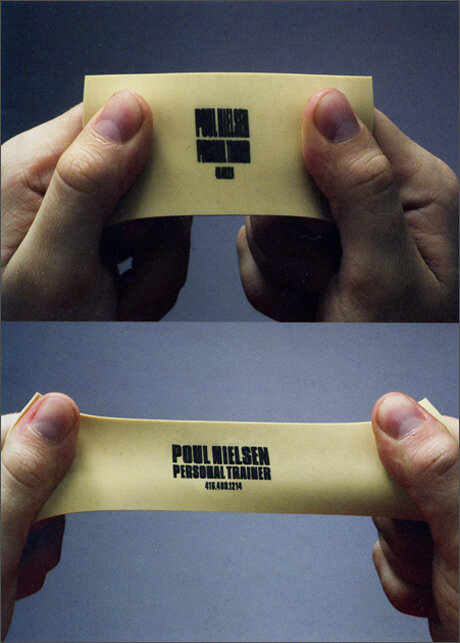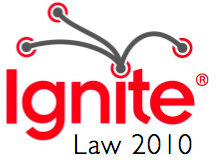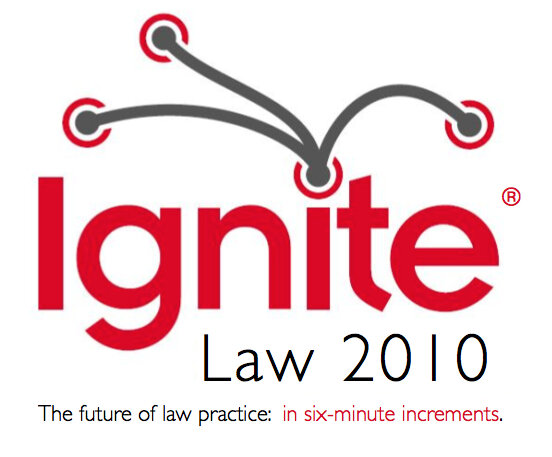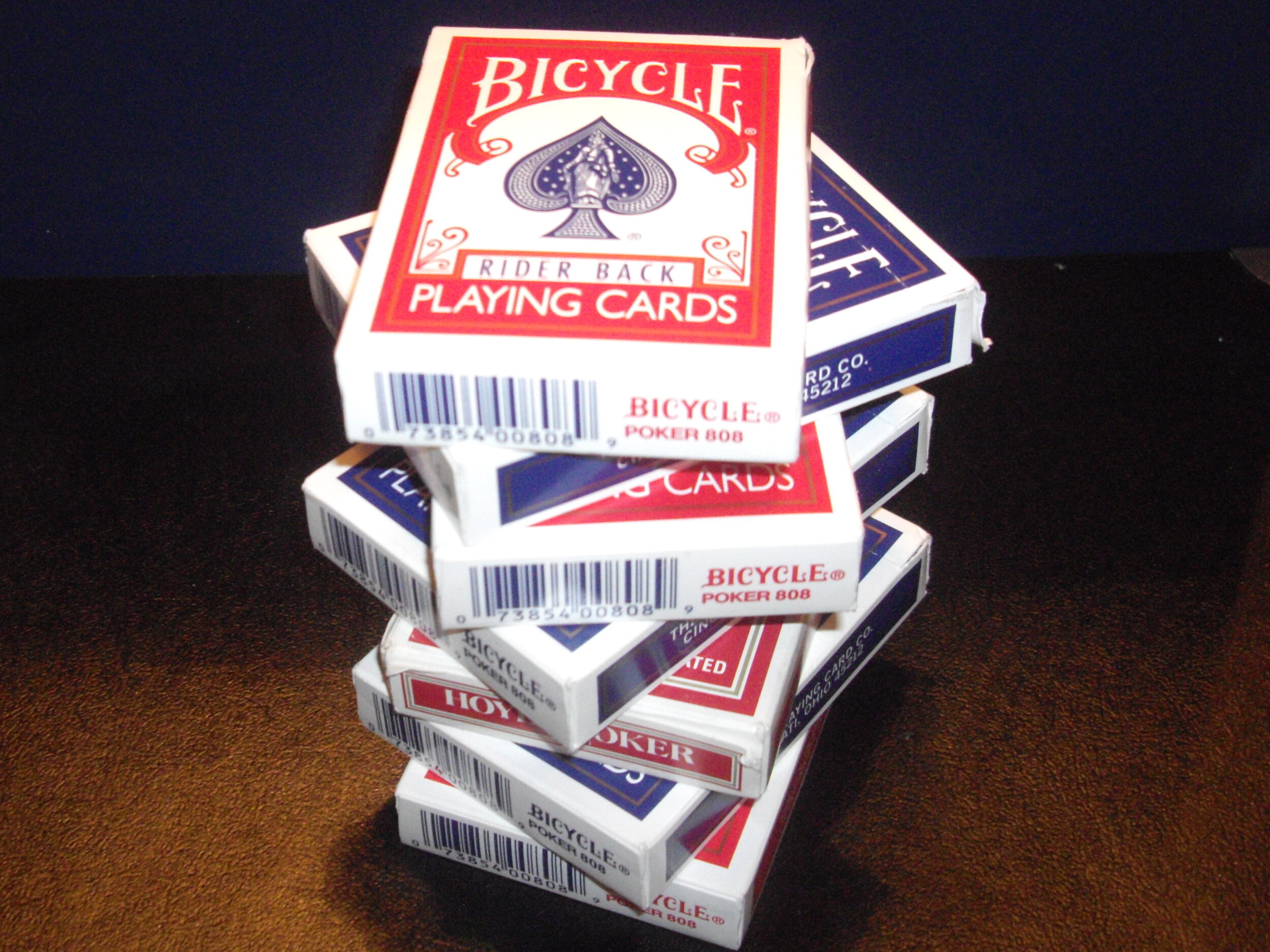Ignite Law 2011 Speakers Named
The official speaker roster for Ignite Law 2011 is set. The event, produced by LexThink CEO Matt Homann and InsideLegal's CEO JoAnna Forshee, will feature 12 speakers sharing their view on the future of law practice and law technology, delivered via 6 minute rapid-fire presentations. Presenters were chosen based on online voting results and include a ‘who’s who’ of legal technology spanning attorneys, legal software executives, legal technologists, consultants and industry bloggers. Ignite Law 2011 takes place on April 10 at the Chicago Hilton, the eve of ABA TECHSHOW.
A total of 25 speaking topics were submitted and based on 1000s of online votes cast, 12 candidates were selected (including 8 'first-timers') to share their 6-minute Ignite presentations. The final Ignite Law 2011 speaker’s list includes:
Jim Calloway – “A Failure to Communicate”
Kevin Chern – “Creating the Perfect Future: Strategic Planning for Your Law Firm and Your Life”
Eric Cooperstein – “(Lack of) Privacy 2.0: Law in the Age of Transparency”
Will Hornsby – “And the survey says...”
Dennis Kennedy – “The Freemium Practice of Law”
Stephanie Kimbro – “Call of Duty: Legal Ops: Serving DIY Clients”
Marc Lauritsen – “Apps for Justice – Code to the Rescue”
Victor Medina – “Bespoke Legal Services in an Off-The-Rack Culture”
Tom Mighell – “Preparing for the Post-PC Law Practice”
Kevin O'Keefe – “Facebook: Can it be really be used by lawyers and law firms for professional and business development? How so?”
Dan Schwartz – “The Elephant in the Room”
Jay Shepherd – “Quantum Leap: How You Will Practice Law in 2019”
Free tickets for the event are still available and can be secured here.
Profit by Giving Your Fees Away
I saw this little blurb on the Church Marketing Sucks blog:
WaterFront Community Church says, “We’re going to give away 100% of our offering to help build and beautify our community.”
What would the impact be if your firm did the same thing, and donated one day's fees a year (or month) to make your community better?
I think it is a great idea -- and could be even better if combined with a contest (like Pepsi's Refresh Project) that sought entries from school children or community groups. What do you think?
How Much Should Legal Fees Be?
Lawyers, do you think clients would use a service that describes itself as follows:
We are an independent, unbiased resource designed to deliver legal fee and price transparency and the expert information legal clients need. Our team of expert lawyers has helped us comb through a mountain of flat fee and billable time data to ensure you have the information you need when it's time to hire a lawyer.
Well, that service doesn't exist for legal clients just yet (as far as I know), but it does for people with car trouble. It is called RepairPal, and it gives people pricing advice (including printed estimates) for various auto service repairs. Here's how it works:
RepairPal takes the mystery out of car repairs with a simple tool thatwill tell you the average price you should be paying for a repair inyour zip code. You just pop in a few details about your repair andcar, and it will do the rest. It breaks down the estimated repair costin a few ways, showing you the range to expect depending on whether yougo through a dealer or independent repair shop, the cost of labor andparts, plus the parts usually needed and how much they cost. Theresult? You can feel better about making an informed repair decision,and you don’t have to scramble to get your friend the “car expert” onthe phone to ask a dozen questions.
Imagine a world where your clients' expectations of the cost of your services is driven less by the facts of their case and more by an "estimate" they got from the internet. A brave new world is coming. Are you ready for it?
Stretch Your Thinking About Biz Cards
One of my favorite business cards of all time:

Check out the entire post at Creative Bits for lots of other cool, inspirational cards.
Ten (New) Truths of CLE
To many lawyers, their state-mandated continuing legal education (CLE) is a necessary chore to be completed, rather than an anticipated opportunity to hone their skills in an exciting and stimulating environment. Part of the reason lawyers don’t love CLE more is that the traditional panel-centric format has -- to put it nicely -- grown stale. Even if listening to three speakers reading their slides worked once, it doesn’t work now. The audience has changed -- and the industry must change with it.
In this article, I offer ten observations, tips and even some advice to those in the CLE business. Though these aren’t my talking points, they mirror much of what I’m going to be speaking about at the Association for Continuing Legal Education (ACLEA) in my talk “The Innovative CLE: Ten Bold Proposals for Change” later this month in New York City.
1. If you ask your attendees what they’re buying from you and they answer “CLE credit,” you’ve got a terrible problem. Stop selling credit, and instead sell understanding, collaboration and community. Give lawyers what they need to keep their clients happy -- not just what they need to keep their license.2. Your audience has far less attention to pay than they once did. Recognize that your events must change because your attendees already have. And never confuse your audience’s attendance for their attention: while you only have to earn their attendance once, you’ve got to earn their attention all event long.
3. Your audience’s ability to pay attention at your event is inversely proportional to their ability to pay attention to the outside world. There’s a very fine line between supporting their technology and giving them yet another way to check their fantasy football standings.
4. Lawyers love online CLE -- not because it improves upon the in-person experience, but because it duplicates it. If lawyers are going to passively consume information from a speaker or panelist, they might as well do it from their desk as they get some “real” work done. If you want lawyers to attend your programs, offer them something they can’t get online, like the ability to work with (and learn from) the other attendees in the room.
5. Convincing lawyers to attend your programs begins with answering their one simple question: “How will this make me better at what I do?” Focus less on the specific things they’ll learn, and more upon how their practice will improve the moment they leave your event.
6. People complain loudest about the price of things they don’t want to buy. If your customers say your prices are too high, focus first on giving them more value -- and if you must cut the price, don’t be afraid to give them less. Also, never forget that the price of your event matters less to attendees than their cost to attend it.
7. Your attendees will get far more “networking” done when they are thinking together than when they are drinking together.
8. Imagine a second-grade class room where the teacher never makes time toanswer the students’ questions. Asking 300 people, with two minutesleft before the next session starts, “Are there any questions?” is alot like that.
9. You aren’t serving lawyers well if you refuse to teach them to attract great clients and run their businesses better. It is a hell of a lot easier to be a competent, ethical attorney when you’re not worried about keeping your lights on and your family fed.
10. Just because your audiences aren’t asking for a better experience doesn’t mean they don’t deserve one. Henry Ford once said, “If I’d asked people what they wanted, they would have said faster horses.” Think about ways to build a better CLE. Experiment, and try new and novel things. Your audience is far more likely to forgive your ambitiousness as they are to tolerate your ambivalence.
Who Can Change Your Firm?
I ran across this idea from an interview with a "Disney Expert" Bill Capodagli in this 37 Signals post on supportive conflict. It seems Disney gave everyone in the organization an opportunity to "pitch" a movie to the heads of the company:
Take the regular meeting they hold called The Gong Show, which is based on the old TV amateur-hour show. It's a concept where, two or three times a year, any Disney employee can present an idea for a full-length feature animation before Michael Eisner, CEO and chairman of the board, and Roy Disney, vice chairman of the board, and other executives. Hercules, the animated film, for example, came about from an animator's idea that was presented at a Gong Show. The company benefits because they get thousands of good ideas from their employees, some of which are developed into feature films. And the employees benefit because they know they have the freedom to submit ideas that will be listened to. Even if their idea is "gonged," they celebrate it and learn from it.
Does your firm give every employee -- from junior partner to part-time file clerk -- the chance to share their ideas for ways to make the firm better? It should!
For the Low Monthly Cost of ...
File this one in the "If Doctors Can Do It..." file. Qliance is one of a number of medical startups that aim to deliver high-quality care directly to consumers for a monthly fee -- without involving insurance providers at all. From the website:
We're using a monthly membership approach to health care, cutting out insurance and going directly to our patients to provide the most comprehensive, high quality primary care out there. The Qliance membership approach means you can see your doctor whenever you need to - even after work and on weekends. By eliminating the hassles of insurance, we are able to put our patients first and return control of your health care to you and to your doctor.
What services could you offer to your prospective clients on a monthly-fee basis? Before you dismiss that question out of hand, check out the Qliance site. If doctors can deliver high-quality medical service to patients (whenever and wherever they need them) for a set monthly fee, surely lawyers can do it for their clients. Right?
Do Your Clients "Like" Your Bills?
What if your clients could "Like" something just as they do on Facebook? Would they "Like" the things you send to them? If not, what could you do to make them dislike those things less?

Stamp from Nation Design Studio.
The Creative Counsel
Here's the slide deck from my presentation to the Association of Corporate Counsel's meeting in St. Louis last month. The audience was (mostly) in-house counsel, and the presentation was geared at getting them to think a bit differently about their relationship with outside counsel. I hope you like it.
Build Your Culture Like Zappos Does
File this one under the "Hmmmmm, that's kinda cool!" category. In this Inc. Magazine article, Zappos.com CEO Tony Hsieh talks about why he (reluctantly) sold his company to Amazon.
What stood out to me, was his take on keeping his company's famous culture alive, even as they grow:
I've noticed that at company happy hours, you don't see as manyemployees from different departments hanging out with one another.
To address that, we've begun tracking employee relationships. Whenemployees log in to their computers, we ask them to look at a pictureof a random employee and then ask them how well they know that person-- the options include "say hi in the halls," "hang out outside ofwork," and "we're going to be longtime friends." We're starting to keeptrack of the number and strength of cross-departmental relationships --and we're planning a class on the topic. My hope is that we can havemore employees who plan to be close friends.
Imagine a law firm doing that!
KickStart Your New Practice
Want to start a new law firm, but lacking the cash to make it happen? Check out KickStarter, a really unique way to "fund creative ideas and ambitious endeavors" by reaching out to others who want to help.
Would-be entrepreneurs post an idea, and set the amount of money it would take to make it happen. Site visitors agree to contribute a portion of the startup price -- though no money changes hands unless the project is fully funded.
If you want to see how it all works, check out how a few entrepreneurs are using Kickstarter to raise money to expand their Snow Cone Stand.
Happier Clients Make Fewer Choices
Have you ever tried shopping for toothpaste at Target or Wal-Mart? Once you decide on your brand of toothpaste (I've always been a Crest man), you're still faced with a dizzying array of choices. And, if you're like me, you spend far too much time deciding upon a product and often feel dissatisfied with your ultimate choice.
Turns out we are not alone. In her new book The Art of Choosing, business school professor Sheena Iyengar presents research that proves people's decision making skills worsen when presented with a plethora of choices. In other words, people decide better (and spend more) when given fewer choices.
In this Wall Street Journal article, Professors Iyengar's famous "jam experiment" is detailed:
In a Palo Alto, Calif., supermarket known for its exceptionally vast range of products, she set up two different booths offering shoppers the chance to sample various unusual preserves. One booth offered 24 different options; the other only six. You would think that, with more choices in the first booth, more shoppers who stopped there would find a flavor they liked and go on to buy a jar. But the opposite happened: People tried more samples and bought a lot more jam at the booth with six varieties.The people who stopped at the 24-jam booth didn't say: "Please take away most of these options so I can more easily make a decision." They simply felt overwhelmed and less willing to make any choice at all. The same feeling can arise in people who are offered an array of detailed investment options or in college students who must choose four or five classes from among the hundreds listed in the course catalog. In these situations, perhaps some strategy for choice, established in advance, could help discipline the decision-making process by focusing it on a manageable set of options.
So, next time you have a client conversation, remember that you may be better off discussing a few options instead of many. Instead of giving your clients lots of choices, curate the list down to a solid few. You'll end up with happier, less-confused clients who will thoughtfully consider their options, instead of being overwhelmed by them.
Should You Touch Your Clients More?
There's some very interesting research on the power of touch in business situations. In this Harvard Business Review post, author Peter Bregman, shares this experiment that found that a brief, light touch affects people's decision making:
In one experiment, as a woman showed subjects to their seats in thelab, she lightly and briefly touched some of them on the back of theirshoulder. Then researchers asked the subjects whether they would prefera certain amount of money or whether they'd prefer to gamble for thechance to win more money, receiving nothing if they lost. The peoplewho were touched were 50 percent more likely to take the gamble. 50percent!
And it's not just any touch. A handshake didn't achieve the sameresult. A handshake isn't comforting, but a touch on the shoulder orback is.
Another study, profiled in the New York Times, found that touch can result in:
almost immediate changes in how people think and behave .... Students who received a supportive touch on the back or arm froma teacher were nearly twice as likely to volunteer in class as thosewho did not, studies have found.A sympathetic touch from a doctor leaves people with the impressionthat the visit lasted twice as long, compared with estimates frompeople who were untouched.
Obviously, good taste and propriety should rule the day when it comes to touch, but perhaps next time, instead of expecting that pat on the back from your client, you should give one instead.
Legal Innovation Scarcity
While on an airplane last week, I was catching up on some long-overdue blog reading and ran across this post in Kevin Kelly's ever-fascinating The Technium. Kevin discusses "The Shirky Principle" from author Clay Shirky that says, "Institutions will try to preserve the problem to which they are the solution." Put another way, "Established industries like to focus on established problems," and are often incapable of changing because, like the media industry, "they are still solving the last problem."
As law firms struggle to develop alternative billing models, I wonder if they too, are still busy solving the last problem. Shouldn't their focus instead be on how to deliver the service their clients need and want, instead of just changing the way they charge for what they always have done? It is one of the reasons that small, nimble firms and entrepreneurial start-ups will have far more to say about the future of law practice than the big-firm legal industry will acknowledge. What do you think?
Ignite Law at Techshow
What happens when you give fifteen speakers just six minutes and twenty slides each to discuss their vision of the future of law practice? Ignite Law!
Taking place on the eve of ABA Techshow, Ignite Law will be a fun evening of entertaining, rapid-fire presentations that all answer the simple question: What is the future of law practice?
If you’re interested in submitting a presentation, or if you’d like to attend, act soon!
Check out IgniteLaw.com for more info.
Audit for Obsolescence
Jordan Furlong suggests lawyers and firms conduct an Obsolescence Audit, aimed at identifying aspects of your business that won't survive the next ten years. Here's his checklist of things to look for:
1. Any offering that’s the same no matter who buys it.
2. Any offering essentially the same as your competitors’.
3. Any offering not optimally designed for client value.
4. Any offering that really, truly doesn’t require a lawyer.
Read the entire post for Jordan's elaboration on each point. A fantastic idea!
Resolve to Count Cards
As 2009 draws to a close, we all find ourselves with lots of stuff on our "to do" lists for the next year. Whether your thinking about finding time to meet your deadlines, accomplish your goals or even follow your resolutions, there never seems to be enough time to do it all.
As you begin 2010, Resolve to Count Cards, using this this incredibly powerful exercise I first ran across in 2006. From an article in the now-defunct Worthwhile Magazine (by creativity guru Eric Maisel) comes this gem:
Get seven decks of cards with similar backs. Lay out all sevendecks on your living room rug, backs showing. This is a year of days(give or take). Let the magnitude of a year sink in. Experience thiswonderful availability of time. (This is a powerful exercise.)
Carefully count the number of days between two widely-separatedholidays, for instance New Year's Day and the Fourth of July. Envisionstarting a large project on that first holiday (today!) and completingit by the second.
It also works great with clients! Give it a try.






